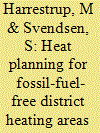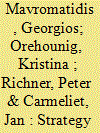|
|
|
Sort Order |
|
|
|
Items / Page
|
|
|
|
|
|
|
| Srl | Item |
| 1 |
ID:
125769


|
|
|
|
|
| Publication |
2013.
|
| Summary/Abstract |
Built environment is responsible for 60% of total energy consumption in European countries and 128 million BOE of primary energy in Belgium. The average energy consumption in the residential buildings of Belgium is 70% higher than the EU average and stands at 348 kW h/m2/year. Energy Performance Building Directive (EPBD) provides guidelines for energy performance analysis of buildings in Belgium. In this study, a holistic approach has been adopted to analyse the building stock of Liege, Belgium. This analysis is based on 'General Socio-economic survey 2001' and 'Housing quality survey 2006 in Walloon region' databases. It considers parameters such as buildings age, built-up area, type of heating system, type of fuel used, adjacency, insulation of roofs and walls and energy consumption etc. for an in depth analysis. This study concludes that about 69% of buildings which are constructed before 1945 needs serious renovation towards the improvement of roof and external wall insulation level. It then successfully identifies specific areas which need detailed study to evaluate the comfort status in the existing building stock, improvement of insulation level and its effect on heating energy consumption as well as the economic analysis on energy efficiency measurements.
|
|
|
|
|
|
|
|
|
|
|
|
|
|
|
|
| 2 |
ID:
105753


|
|
|
|
|
| Publication |
2011.
|
| Summary/Abstract |
On 19 May 2010, the European Union adopted a Directive stipulating that by the end of 2020, Member States must ensure that all newly constructed buildings consume 'nearly zero' energy. In Germany, drastic reductions of energy demand for space heating have already become a policy target over the last decade, both for new and existing dwellings. In this article, we evaluate the impact of past and future policies on the development of buildings with a very high energy performance (VHEP) and on their primary energy demand and emissions. These dwellings account for 4% of all dwellings which have been constructed since 2001 and 1% of the total building stock. We have defined different policy scenarios, all of which assume a gradual increase of requirements for new and existing buildings and a continuation of the support policies that stimulate both new constructions and ambitious refurbishments. In the most ambitious scenario, the proportion of VHEP dwellings will increase by up to 30% of the total stock in 2020 and the share of nearly zero and zero-energy dwellings will then make up 6%. This will lead to emission reductions of over 50% of the 1990 level and primary energy reductions of 25% compared with today.
|
|
|
|
|
|
|
|
|
|
|
|
|
|
|
|
| 3 |
ID:
133150


|
|
|
|
|
| Publication |
2014.
|
| Summary/Abstract |
The Danish government plans to make the Danish energy system to be completely free of fossil fuels by 2050 and that by 2035 the energy supply for buildings and electricity should be entirely based on renewable energy sources. To become independent from fossil fuels, it is necessary to reduce the energy consumption of the existing building stock, increase energy efficiency, and convert the present heat supply from fossil fuels to renewable energy sources. District heating is a sustainable way of providing space heating and domestic hot water to buildings in densely populated areas. This paper is a theoretical investigation of the district heating system in the Copenhagen area, in which heat conservation is related to the heat supply in buildings from an economic perspective. Supplying the existing building stock from low-temperature energy resources, e.g. geothermal heat, might lead to oversized heating plants that are too expensive to build in comparison with the potential energy savings in buildings. Long-term strategies for the existing building stock must ensure that costs are minimized and that investments in energy savings and new heating capacity are optimized and carried out at the right time.
|
|
|
|
|
|
|
|
|
|
|
|
|
|
|
|
| 4 |
ID:
150390


|
|
|
|
|
| Summary/Abstract |
Within the general context of Greenhouse Gas (GHG) emissions reduction, decomposition analysis allows the quantification of the contribution of different factors to changes in emissions as well as the assessment of the effectiveness of policy and technology measures. The Kaya identity has been widely used for that purpose in order to disaggregate carbon emissions into various driving forces. In this paper, it is applied for the analysis of emissions resulting from energy use at three different scales. First, a decomposition analysis of the carbon emissions for the complete Swiss energy system is presented using the future projections from the Swiss Energy Strategy 2050. The Kaya identity is then applied to the Swiss building sector after it is adapted with factors that are more relatable to building parameters, such as floor area instead of Gross Domestic Product (GDP). Finally, the last level of analysis is a small scale community energy system for a unique Swiss village that aims to significantly reduce its emissions. An energy strategy is developed and its effectiveness is assessed with the adapted Kaya identity and benchmarked against the Swiss average values. The presented method demonstrates how the performance of buildings under various retrofitting scenarios can be benchmarked against future emission targets.
|
|
|
|
|
|
|
|
|
|
|
|
|
|
|
|
| 5 |
ID:
119801


|
|
|
|
|
| Publication |
2013.
|
| Summary/Abstract |
Energy policies at the urban level may result in long lasting effects and can successfully influence the energy performances of an urban system if we consider the whole built environment and focus on the energy renovation process in existing buildings. Undoubtedly, cities have a high level of complexity, especially considering problems related to obtaining suitable information about a building's energy performance and consumption.
This study developed a methodology able to characterize the energy performance of the built environment in a city or neighbourhood and to evaluate the effects of different energy strategies. The methodology was designed to be as simple as possible, not time consuming and applicable to all Italian towns, as well as elsewhere, if basic building information are available; the main phases of the methodology were the collection and analysis of the available data about the built environment and the implementation of a Geographic Information Systems (GIS) city buildings database. To test the developed tool, the city of Milan was considered as a case study.
The authors hope that this methodology will be able to support energy policies at the urban level, taking into account the approaches of different stakeholders to develop low carbon models of settlements.
|
|
|
|
|
|
|
|
|
|
|
|
|
|
|
|
|
|
|
|
|